Developing Efficient Thin Film Temperature Sensors Utilizing Layered Carbon Nanotube Films
Abstract
:1. Introduction
2. Experimental Work
2.1. Substrate Preparation by Sputtering
2.2. CNT Film Synthesis
2.3. Characterization
3. Results and Discussion
3.1. CNT Morphology and Microstructures
3.2. Raman Spectroscopy Results
3.3. Electrical Characterization
3.3.1. Hall Coefficient Measurement through van der Pauw
3.3.2. TCR of CNT Film
4. Conclusions and Future Work
Author Contributions
Funding
Acknowledgments
Conflicts of Interest
Appendix A
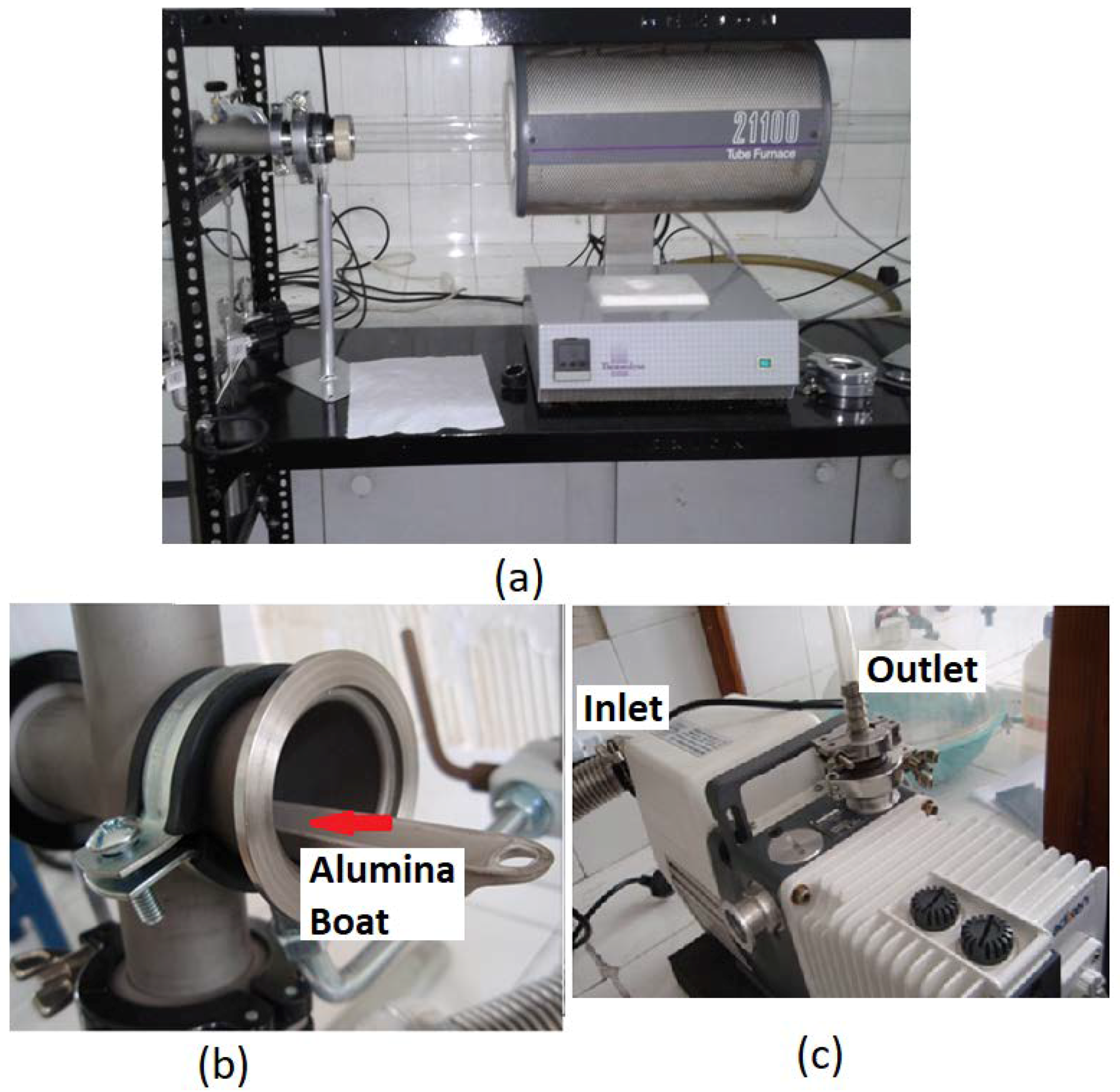
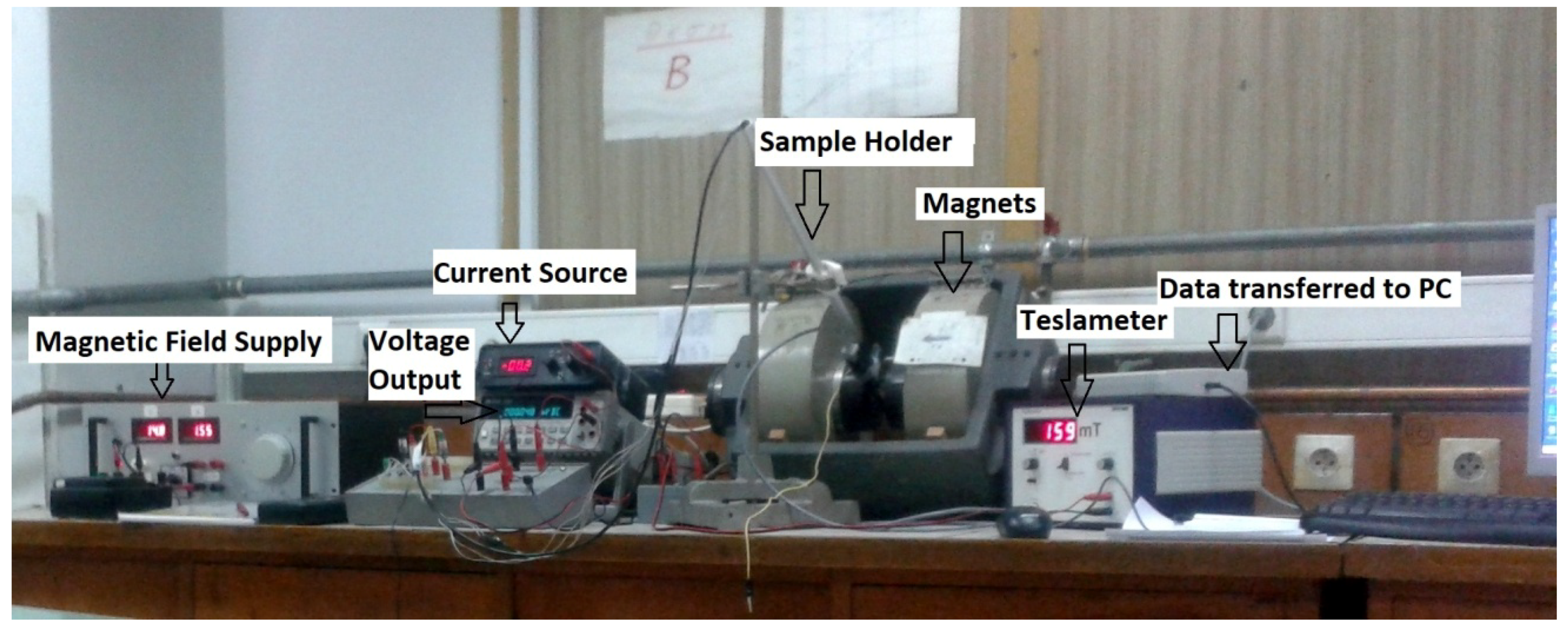
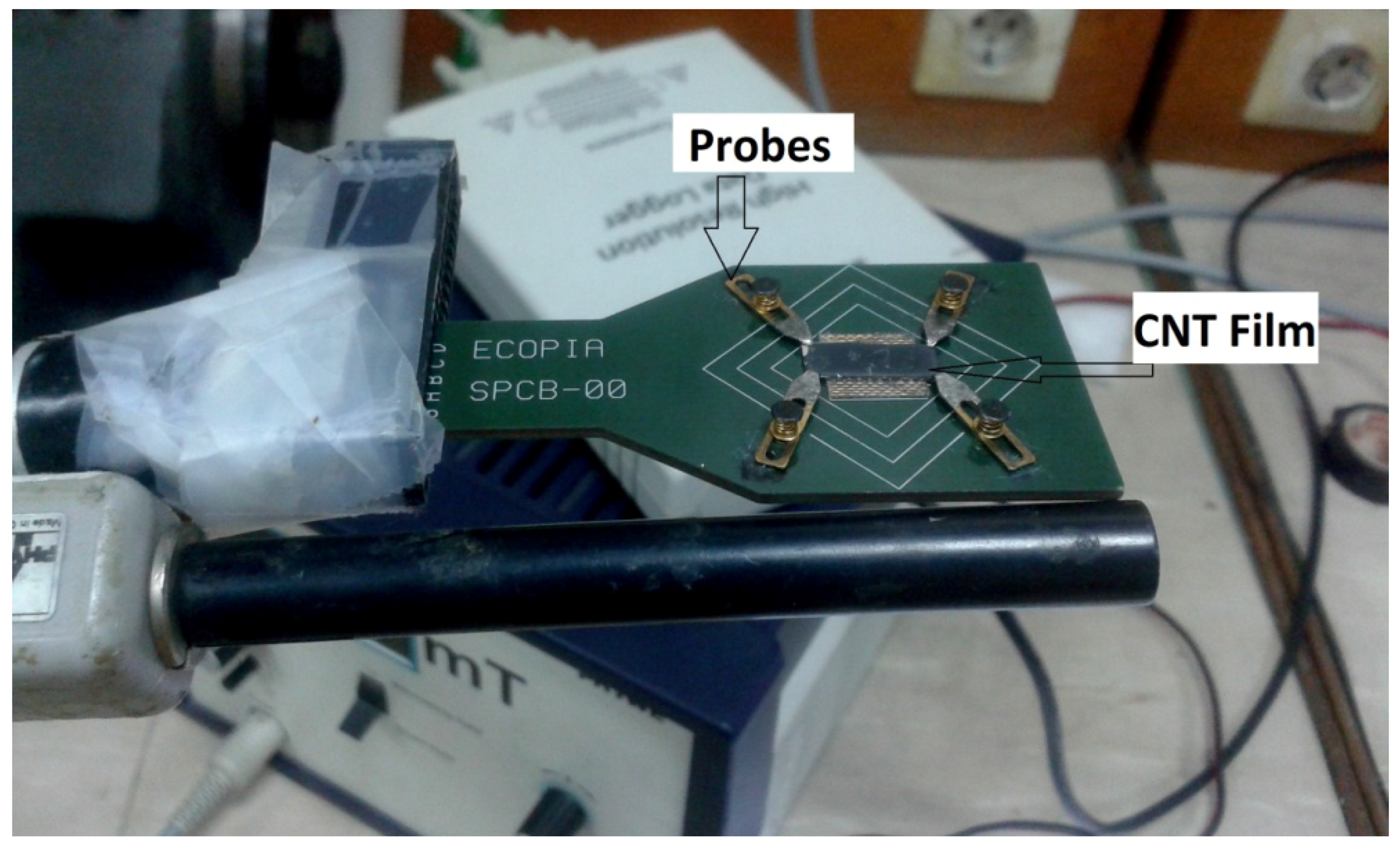

References
- Sarma, S.; Unal, A.; Sahoo, N. Thin Film Gauges using Carbon Nanotubes as Composite Layers. ASME J. Eng. Mater. Technol. 2015, 138, 041014. [Google Scholar] [CrossRef]
- Henze, M.; Bogdanic, L.; Muehlbauer, K.; Schnieder, M. Effect of the Biot Number on Metal Temperature of Thermal Barrier Coated Turbine Parts—Real Engine Measurements. ASME J. Turbomachin. 2013, 135, 031029. [Google Scholar] [CrossRef]
- Patil, P.S.; Belsare, S.N.; Borse, S.L. Analysis of Internal Combustion Engine Heat Transfer Rate to Improve Engine Efficiency, Specific Power & Combustion Performance Prediction. Int. J. Mech. Eng. Technol. 2012, 3, 447–752. [Google Scholar]
- Mortazavinatanzi, S.; Rezaniakolaei, A.; Rosendahl, L. Printing and Folding: A Solution for High-Throughput Processing of Organic Thin-Film Thermoelectric Devices. Sensors 2018, 18, 989. [Google Scholar] [CrossRef] [PubMed]
- Jiang, H.; Huang, M.; Yu, Y.; Tian, X.; Zhao, X.; Zhang, W.; Zhang, J.; Huang, Y.; Yu, K. Integrated Temperature and Hydrogen Sensors with MEMS Technology. Sensors 2018, 18, 94. [Google Scholar] [CrossRef] [PubMed]
- Sahoo, N.; Saravanan, S.; Jagadeesh, G.; Reddy, K.P.J. Simultaneous Measurement of Aerodynamic and Heat Transfer Data for Large Angle Blunt Cones in Hypersonic Shock Tunnel. Sadhana 2006, 31, 557–581. [Google Scholar] [CrossRef]
- Bartolomeo, A.D.; Sarno, M.; Giubileo, F.; Altavilla, C.; Iemmo, L.; Piano, S.; Bobba, F.; Longobardi, M.; Scarfato, A.; Sannino, D.; et al. Multiwalled Carbon Nanotube Films as Small Sized Temperature Sensors. J. Appl. Phys. 2009, 105, 064518. [Google Scholar] [CrossRef]
- De Volder, M.; Reynaerts, D.; Hoof, C.V.; Tawfick, S.; Hart, A.J. A Temperature Sensor from a Self-Assembled Carbon Nanotube Microbridge. IEEE Sens. 2010, 2369–2372. [Google Scholar] [CrossRef]
- Sibinski, M.; Jakubowska, M.; Sloma, M. Flexible Temperature Sensors on Fibers. Sensors 2010, 10, 7934–7946. [Google Scholar] [CrossRef] [PubMed] [Green Version]
- Panagiotopoulos, N.T.; Diamanti, E.K.; Koutsokeras, L.E.; Baikousi, M.; Kordatos, E.; Matikas, T.E.; Gournis, D.; Patsalas, P. Nanocomposite Catalysts Producing Durable, Super-Black Carbon Nanotube Systems: Applications in Solar Thermal Harvesting. ACS Nano 2012, 6, 10475. [Google Scholar] [CrossRef] [PubMed]
- Kong, J.; Cassell, A.M.; Dai, H. Chemical Vapor Deposition of Methane for Single-Walled Carbon Nanotubes. Chem. Phys. Lett. 1998, 292, 567–574. [Google Scholar] [CrossRef]
- Kong, J.; Hyongsok, T.S.; Cassell, A.M.; Quate, C.F.; Dai, H. Synthesis of Individual Single-Walled Carbon Nanotubes on Patterned Silicon Wafers. Nature 1998, 395, 878–881. [Google Scholar] [CrossRef]
- Ducati, C.; Alexandrou, I.; Chhowalla, M.; Amaratunga, G.A.J.; Robertson, J. Temperature Selective Growth of Carbon Nanotubes by Chemical Vapor Deposition. J. Appl. Phys. 2002, 92, 3299. [Google Scholar] [CrossRef]
- Dresselhaus, M.S.; Jorio, A.; Saito, R. Characterizing Graphene, Graphite, and Carbon Nanotubes by Raman Spectroscopy. Ann. Rev. Cond. Matter Phys. 2010, 1, 89–108. [Google Scholar] [CrossRef] [Green Version]
- Ferrari, A.C.; Robertson, J. Interpretation of Raman Spectra of Disordered and Amorphous Carbon. Phys. Rev. B 2000, 61, 14095–14107. [Google Scholar] [CrossRef]
- Chhowalla, M.; Teo, K.B.K.; Ducati, C.; Rupesinghe, N.L.; Amaratunga, G.A.J.; Ferrari, A.C.; Roy, D.; Robertson, J.; Milne, W.I. Growth Process Conditions of Vertically Aligned Carbon Nanotubes using Plasma Enhanced Chemical Vapor Deposition. J. Appl. Phys. 2001, 90, 5308–5317. [Google Scholar] [CrossRef]
- Bokobza, L.; Zhang, J. Raman Spectroscopic Characterization of Multiwall Carbon Nanotubes and of Composites. Express Polym. Lett. 2012, 6, 601–608. [Google Scholar] [CrossRef]
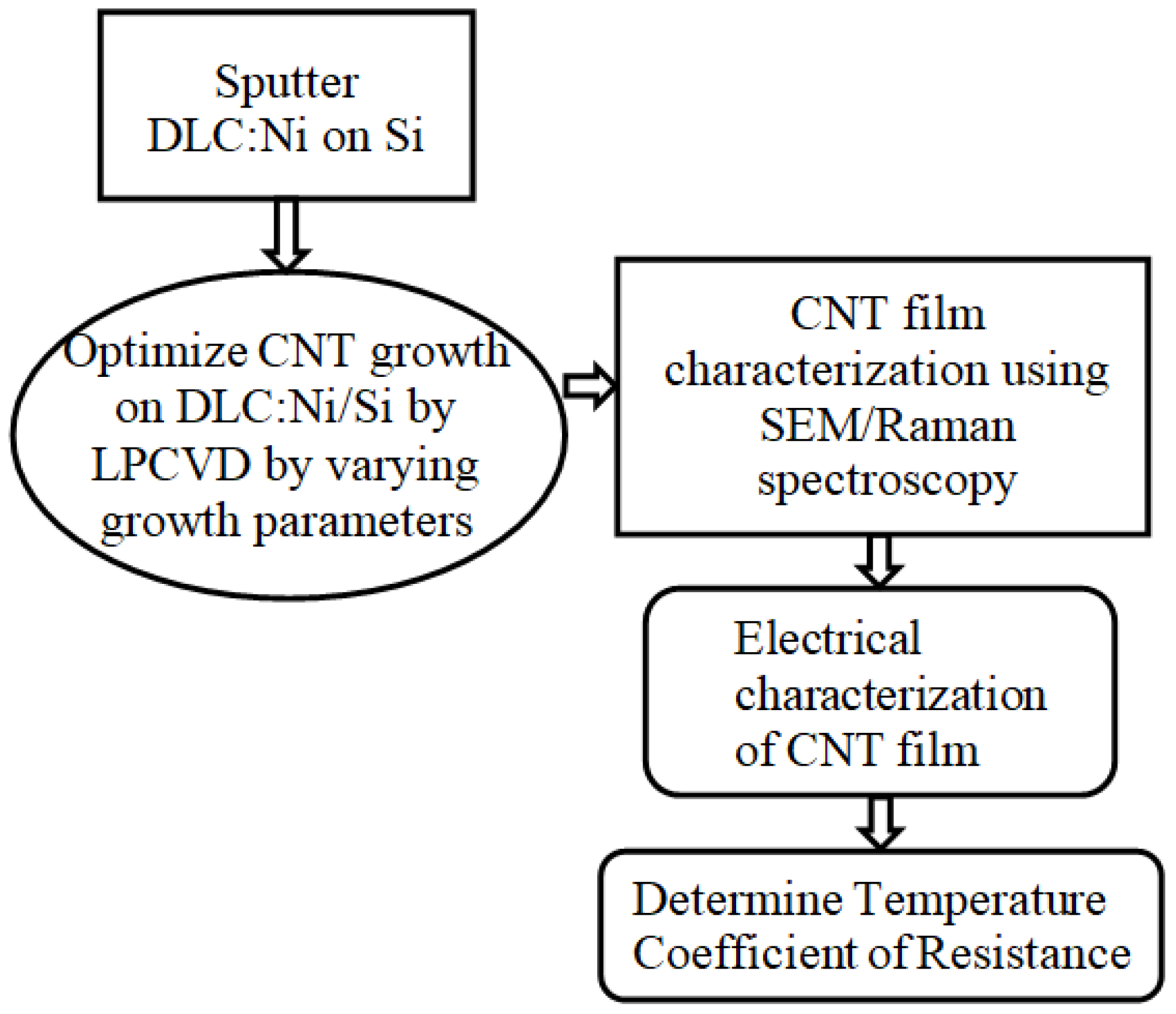

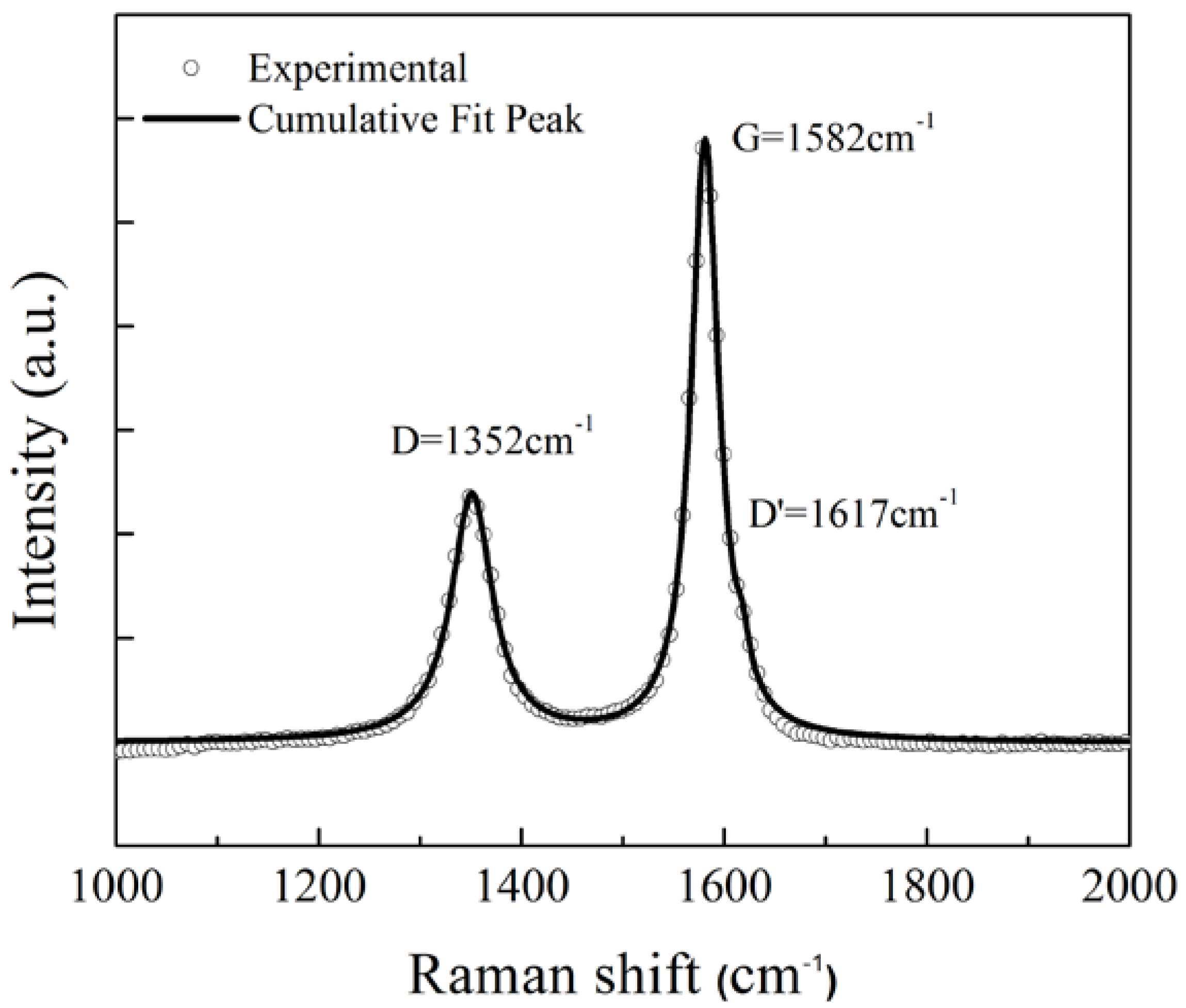


| Sample | D | G | D′ | ID/IG | |
|---|---|---|---|---|---|
| CNT/DLC:Ni/Si | Peak center | 1352.38 | 1582.12 | 1617.2 | 0.6 |
| FWHM | 51.32 | 32.81 | 23.56 |
| Sample | Film Thickness (m) | Resistivity (ρ) in Ω.cm | Sensitivity in V/˚C | Conductivity (σ) in Ω.cm−1 | Carrier Mobility (μ) in cm2/Vs |
|---|---|---|---|---|---|
| CNT/DLC:Ni/Si | 2.70 × 10−6 | 8.64 × 10−4 | 3.3 × 10−3 | 1157.41 | −28.5574 |
© 2018 by the authors. Licensee MDPI, Basel, Switzerland. This article is an open access article distributed under the terms and conditions of the Creative Commons Attribution (CC BY) license (http://creativecommons.org/licenses/by/4.0/).
Share and Cite
Sarma, S.; Lee, J.H. Developing Efficient Thin Film Temperature Sensors Utilizing Layered Carbon Nanotube Films. Sensors 2018, 18, 3182. https://doi.org/10.3390/s18103182
Sarma S, Lee JH. Developing Efficient Thin Film Temperature Sensors Utilizing Layered Carbon Nanotube Films. Sensors. 2018; 18(10):3182. https://doi.org/10.3390/s18103182
Chicago/Turabian StyleSarma, Shrutidhara, and Jang Ho Lee. 2018. "Developing Efficient Thin Film Temperature Sensors Utilizing Layered Carbon Nanotube Films" Sensors 18, no. 10: 3182. https://doi.org/10.3390/s18103182





